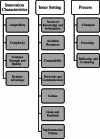Formative Evaluation of CLABSI Adoption and Sustainment Interventions in a Pediatric Intensive Care Unit
- PMID: 38576891
- PMCID: PMC10990306
- DOI: 10.1097/pq9.0000000000000719
Formative Evaluation of CLABSI Adoption and Sustainment Interventions in a Pediatric Intensive Care Unit
Abstract
Background: Pediatric patients require central venous catheters to maintain adequate hydration, nutritional status, and delivery of life-saving medications in the pediatric intensive care unit. Although central venous catheters provide critical medical therapies, their use increases the risk of severe infection, morbidity, and mortality. Adopting an evidence-based central line-associated bloodstream infection (CLABSI) bundle to guide nursing practice can decrease and sustain low CLABSI rates, but reliable and consistent implementation is challenging. This study aimed to conduct a mixed-methods formative evaluation to explore CLABSI bundle implementation strategies in a PICU.
Methods: The team used The Consolidated Framework for Implementation Research to develop the interview guide and data analysis plan.
Results: Facilitators and barriers for the CLABSI bundle occurred in four domains: inner setting, process, characteristics of individuals, and innovation characteristics in each cycle that led to recommended implementation strategy opportunities. The champion role was a major implementation strategy that facilitated the adoption and sustainment of the CLABSI bundle.
Conclusions: Implementation Science Frameworks, such as Consolidated Framework for Implementation Research (CFIR), can be a beneficial framework to guide quality improvement efforts for evidence-based practices such as the CLABSI bundle. Using a champion role in the critical care setting may be an important implementation strategy for CLABSI bundle adoption and sustainment efforts.
Copyright © 2024 the Author(s). Published by Wolters Kluwer Health, Inc.
Figures




Similar articles
-
Harnessing implementation science to optimize harm prevention in critically ill children: A pilot study of bedside nurse CLABSI bundle performance in the pediatric intensive care unit.Am J Infect Control. 2021 Mar;49(3):345-351. doi: 10.1016/j.ajic.2020.08.019. Epub 2020 Aug 18. Am J Infect Control. 2021. PMID: 32818579 Free PMC article.
-
How to minimize central line-associated bloodstream infections in a neonatal intensive care unit: a quality improvement intervention based on a retrospective analysis and the adoption of an evidence-based bundle.Eur J Pediatr. 2021 Feb;180(2):449-460. doi: 10.1007/s00431-020-03844-9. Epub 2020 Oct 20. Eur J Pediatr. 2021. PMID: 33083900
-
The impact of central line bundles on the timing of catheter-associated bloodstream infections and their microbiological distribution in critically ill children.Eur J Pediatr. 2023 Oct;182(10):4625-4632. doi: 10.1007/s00431-023-05141-7. Epub 2023 Aug 9. Eur J Pediatr. 2023. PMID: 37555974
-
Meta-analysis of the central line bundle for preventing catheter-related infections: a case study in appraising the evidence in quality improvement.BMJ Qual Saf. 2016 Feb;25(2):118-29. doi: 10.1136/bmjqs-2014-003787. Epub 2015 Jul 16. BMJ Qual Saf. 2016. PMID: 26183714 Review.
-
APSIC guide for prevention of Central Line Associated Bloodstream Infections (CLABSI).Antimicrob Resist Infect Control. 2016 May 4;5:16. doi: 10.1186/s13756-016-0116-5. eCollection 2016. Antimicrob Resist Infect Control. 2016. PMID: 27152193 Free PMC article. Review.
References
-
- Ares G, Hunter C. Central venous access in children: indications, devices, and risks. Curr Opin Pediatr. 2017;29:340–346. - PubMed
-
- Center for Disease Control and Prevention. Bloodstream Infection Event (Central Line-Associated Bloodstream Infection and Non-Central Line Associated Bloodstream Infection). Available at https://www.cdc.gov/nhsn/pdfs/pscmanual/4psc_clabscurrent.pdf. Published 2023. Accessed May 5, 2023.
-
- Wolf J, Curtis N, Worth LJ, et al. . Central line-associated bloodstream infection in children: an update on treatment. Pediatr Infect Dis J. 2013;32:905–910. - PubMed
LinkOut - more resources
Full Text Sources
